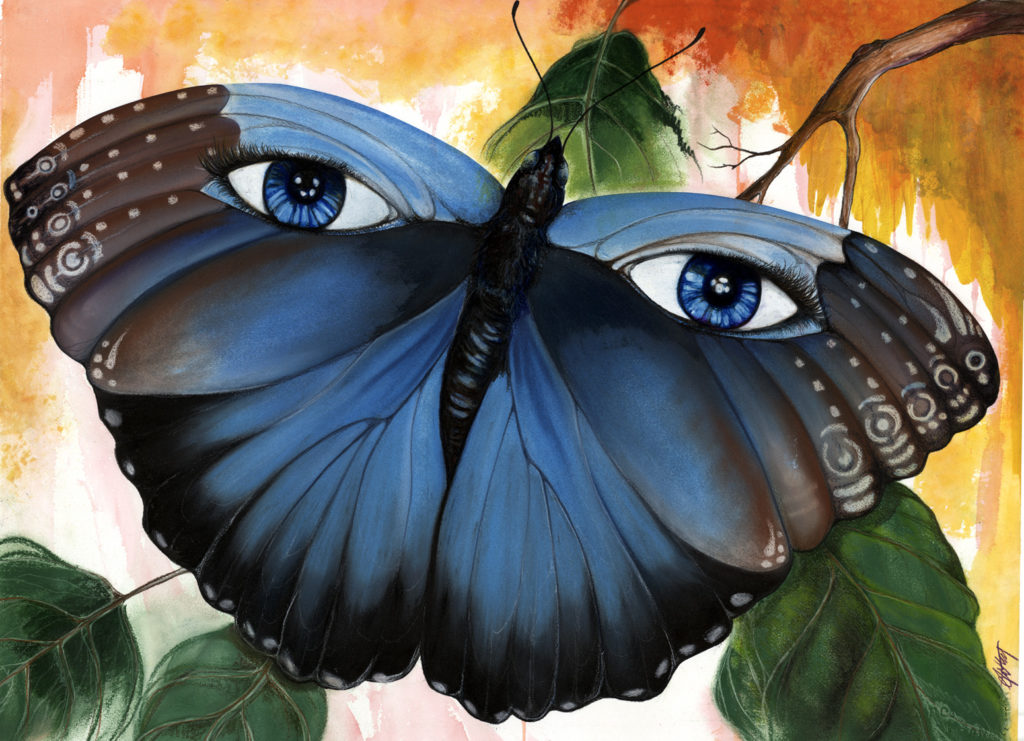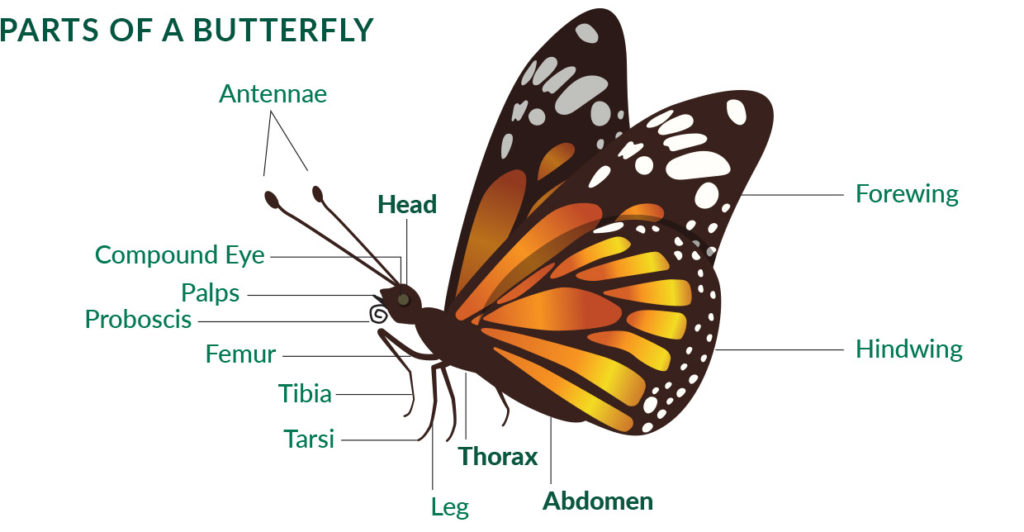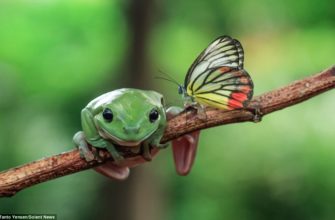Butterflies are fascinating creatures with a complex anatomical structure that contributes to their unique abilities. Their anatomy includes intricate respiratory, circulatory, digestive, and nervous systems. The body consists of a head, thorax, and abdomen. The wings are attached to the thorax and are covered in overlapping scales. The antennae on the head house sensory organs that allow butterflies to perceive chemical signals in their environment.
The compound eyes of butterflies play an essential role in locating mates and food sources. They have two large compound eyes on either side of the head that consist of numerous photoreceptor elements known as ommatidia. These ommatidia detect light intensity, polarization, and coloration contributing to the butterfly’s ability to navigate through obstacles effortlessly.
In addition to their impressive vision capabilities, butterflies also have an extraordinary sense of smell. Their proboscis is an elongated tube-like mouthpart consisting of long hairs that harbor taste receptors that enable them to recognize different flavors such as nectar or pollen. Butterflies use their proboscis like a straw, sipping fluid from flowers or other sources.
To support butterfly populations in your area, try planting native flowers or setting up a butterfly habitat with appropriate host plants for caterpillars such as milkweed or parsley. Providing shelter from harsh weather conditions can also benefit these delicate creatures who depend on a healthy ecosystem for their survival.
Why did the butterfly need so many eyes? To keep an eye on its caterpillar investments.
The Eyes of a Butterfly

To understand the intricacies of the eyes of a butterfly, hone in on the key sub-sections: number of eyes and types of eyes. By delving into these sub-sections, you can gain deeper insight into the unique visual capabilities of these insects.
Number of Eyes
Butterfly Vision: Insights on their Unique Optical System
The visual system in butterflies is intriguing, with intricate adaptations that enable them to see the world differently from many other insects. Some of these adaptations include their astonishing variety of eyes and an impressive ability to perceive color in intricate detail.
Here are six notable features of butterfly vision:
- Butterflies have two distinct types of eye: simple eyes known as ocelli used for detecting light intensity, and compound eyes consisting of thousands of individual lenses used for detailed vision.
- Underneath the photoreceptors in their compound eyes lies an arrangement comprising mirror-like structures that allow for polarization sensitivity.
- Many species have additional visual receptors in the front legs, which complement the compound eye sensory input.
- Their compound eyes can detect UV light; some butterflies use complex UV patterns on flower petals to locate food sources.
- The shape of a butterfly’s eye varies by species and plays a role in determining what kind of information is most useful for it to process given its lifestyle and behaviors. For example, hunters will have narrow-shaped frontal lobes compared to social species.
- Butterflies are capable of long-range surveillance without moving their heads thanks to an expanded field-of-view enabled by their fused eyes covering almost the entire circumference around their heads except for a small circle directly behind them.
Furthermore, unlike many other animals, butterflies’ vision doesn’t deteriorate with age since they can prevent cell degeneration using unique pigment-production techniques.
Pro Tip: Want to attract butterflies to your garden? Incorporate brightly colored flowers with high ultraviolet reflectivity since they find them irresistible.
From compound to simple, the variety of butterfly eyes will make your own peepers feel basic and unimpressive.
Types of Eyes
Eyes in the Animal Kingdom: A Brief Overview
Different species of animals have evolved to have various types of eyes, each adapted to their unique environments and lifestyles. From simple eyespots to complex compound eyes, the range of vision among animals is remarkable.
Types of Animal Eyes
| Eye Type | Organisms | Unique Characteristics |
|---|---|---|
| Simple eyes | Flatworms, snails, worms | Detect light and shadow |
| Compound eyes | Insects, crustaceans, some arachnids | Provide panoramic view |
| Camera-like eyes | Vertebrate animals such as fishes, reptiles, birds, mammals | Have a single lens for focusing light |
In addition to these three main types of animal eyes, there are also specialized types such as eye cups found in jellyfish and box jellyfish that detect sunlight and polarization patterns. Certain deep-sea fish with reflector cells can also see bioluminescent light.
Did you know that mantis shrimps possess one of the most complex eyes among animals? Their eyes have sixteen color-receptive cones compared to the three color-receptive cones in human eyes! (Source: The Guardian)
Who needs high-def when you have the compound eyes of a butterfly, capturing every detail in trippy, kaleidoscopic glory?
The Function of Butterfly Eyes

To understand the function of butterfly eyes with sight, color recognition, and ultraviolet vision, this section examines how these features help butterflies survive and thrive. By exploring the sub-sections, you will gain a deeper appreciation for the unique abilities of butterfly eyes and their importance in the natural world.
Sight
The visual system of butterflies is vital for survival in their natural environment. Through a complex network of eyes, they are able to effectively detect predators and locate food sources. These eyes, known as compound eyes, consist of thousands of individual lenses called ommatidia. This allows them to have a wide field of vision and sense movement from multiple angles.
Butterfly eyes also have the ability to see ultraviolet light, which is undetectable to the human eye. This allows them to identify flowers with nectar that would otherwise be invisible.
Moreover, these tiny creatures can distinguish between colors that appear almost identical to humans due to their unique ability to detect polarized light. This feature helps them navigate through their surroundings even on cloudy days.
Did you know that butterfly eyes were once used by ancient civilizations for decorative purposes? The Aztecs used butterfly wings as ornaments and believed they had sacred powers. These seemingly delicate creatures continue to fascinate us with their incredible sight and beauty.
Who needs color vision when you have butterfly eyes that see more hues than a Pantone chart?
Color Recognition
Butterfly Eyes: Deciphering the Spectrum of Colors
Butterflies’ eyes have a remarkable ability to recognize the spectrum of colors, allowing them to differentiate between different species and locate nectar sources. Their compound eyes comprise thousands of ommatidia, each containing its own photoreceptor cell set at a slightly different angle, enabling them to sense wavelengths beyond human vision.
These specialized cells feed information into the optic lobe, where it is processed and interpreted into distinct hues. Moreover, butterflies can see ultraviolet light that reflects off flower petals or fur of other insects, aiding them in selecting optimal feeding locations.
Interestingly, research has demonstrated that colorful markings on a butterfly’s wings may not be solely for attracting mates or warding off predators but also for color-specific communication signals that their rivals cannot detect.
To help preserve butterfly populations within various ecosystems, planting native flowers could provide abundant sources of nectar for these pollinators. Additionally, decreasing pesticide use would ensure that they do not inadvertently consume harmful chemicals while feeding. By understanding the complexities of their vision and needs, we can protect these delicate creatures for generations to come.
Just when you thought butterflies couldn’t get any cooler, they go and have ultraviolet vision. Talk about seeing the world in a whole new light.
Ultraviolet Vision
Butterflies use their ability to see ultraviolet light to locate flowers with nectar and potential mates. This vision allows them to perceive patterns on flowers that are invisible to the naked eye, as well as detect the unique UV reflections of other butterflies. The structure of their eyes is designed to filter out all but UV light, also allowing them to navigate in low light conditions.
This unique ability gives butterflies a competitive advantage in survival and reproduction. Understanding how they use this vision can provide insights for scientists studying optics and animal behavior.
Looks like even butterflies have their own unique Eye-Dentity.
Differences in Eye Structure Among Butterfly Species

Butterflies have varying eye structures, which make them unique. These variations in eye structures among butterfly species allow for different vision capabilities and behaviors. To understand this better, we can examine the characteristics of their eyes.
| Eye Structure | Number of Eyes | Eye Color | Eye Placement |
|---|---|---|---|
| Simple | Two | Black | On Head |
| Compound | Two | Multicolored | On Head |
| Ocelli | Two to five | Black | On Head or Thorax |
In terms of eye structure, butterflies possess simple, compound, and ocelli eyes. Simple eyes are usually black and located on a butterfly’s head. Compound eyes are multicolored and also situated on the head. Finally, ocelli eyes can be found either on the head or thorax of a butterfly, with each species having up to five such eyes.
One unique feature is that ocelli does not see images; rather, it senses light intensity changes—allowing them to recognize day/night cycles, enabling butterflies to know when it is safe to fly.
A Lepidopterist shared an experience where they observed the close-up shots of Small Heath Butterflies’ six-compound megapixel-camera-like eyes magnified by an electronic microscope that helped them appreciate the intricate details in vision capability across species.
As seen from above, each butterfly species exhibits unique features in their eye structure and placement. Further research could provide additional insights into how these differences influence their behavior towards food intake or social interactions with other insects.
When it comes to butterflies and their numerous eyes, let’s just say they see more drama than a reality TV show.
Conclusion
After thorough research, it has been determined that butterflies have two large compound eyes. These eyes are made up of thousands of tiny lenses, allowing the butterfly to see a wide range of colors and distinguish ultraviolet patterns. Additionally, some species of butterflies also have simple eyes known as ocelli, which detect light levels and help with balance during flight.
It is interesting to note that the number of ocelli in a butterfly can vary depending on the species and its genus. For instance, some butterfly species have only one ocellus while others may have up to six. This shows that there is variation in the eye structures of butterflies depending on their genetics and adaptation to their environment.
As further understanding into the biology of insects is gained, it becomes clear how integral each organism’s specific adaptations are when considering our ever-changing world. Learning about minute features such as the number of eyes a butterfly has may seem inconsequential at first glance; yet they serve as powerful insights into understanding how an organism interacts within its ecosystem – encouraging us all to learn about this amazing planet we inhabit.








